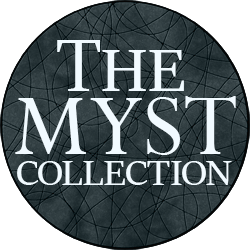
This is a Myst screensaver program that also includes two very basic games.
This software was designed to be compatible with Windows 3.1 and up. Unfortunately, Windows 3.1 included no native screensaver support; each screensaver program had to implement ALL of the functionality on its own. Therefore, when this software is used with a more modern version of Windows, it can't just include itself in Windows' screensaver list. Instead, it has it's own timer functionality built-in, and reccomends disabling Windows' built-in screensaver if you plan to use this.
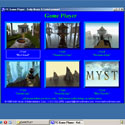 (800 x 600, 0.11 MiB)
(800 x 600, 0.11 MiB)
 (800 x 600, 0.11 MiB)
(800 x 600, 0.11 MiB)
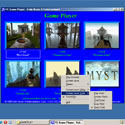 (800 x 600, 0.11 MiB)
(800 x 600, 0.11 MiB)
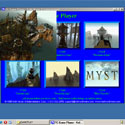 (800 x 600, 0.13 MiB)
(800 x 600, 0.13 MiB)
Unfortunately, the way this is implemented is very crude. Using this as a screensaver requires you to open the software and leave it minimized, or the timer won't run and the screensaver will never trigger. This is entirely due to the limitations of Windows 3.1, but it's unfortunate that there's no forwards compatibility with the native screensaver functionality of later versions of Windows.
Even worse, all of the screensaver modes (and both of the games) are entirely based on six videos bundled with the software, and the videos are incredibly low quality. Each of the six videos is contained in an SVI file, which can be unzipped with most compression utilities. Contained inside each file is a VID file, a SND file, and an INF file. The VID file contains highly compressed video at only 160x120 resolution, with a pitiful 8 frames per second and a miniscule bitrate between 200 and 300 kbps. The SND files aren't much better, containing the audio track in mono PCM format with a sample rate of 11025 Hz and a bitrate near 88 kbps. The INF file is just a text file with some basic copyright and indexing information, and is also where the program stores your choice of video effect for that particular video.
Copies of the six videos can be seen here, converted to a more modern video format:
 "Myst Island"
"Myst Island"
 "Channelwood Age"
"Channelwood Age"
 "Mechanical Age"
"Mechanical Age"
 "Selenitic Age"
"Selenitic Age"
 "Stoneship Age"
"Stoneship Age"
 "Myst Traveler"
"Myst Traveler"
Considering that the jewel case lists SVGA as a minimum system requirement, and considering that a CD-ROM can hold many hundreds of megabytes, it's not immediately obvious why this software uses such low-quality audio and video. However, when viewed through the Internet Archive, kellysoftware.com offers some pertinent information: the GamePlayer software that runs on this disk was not intended to be a high-quality standalone software, but instead was marketed as a very low cost marketing tool. The website advertises the fact that GamePlayer can be bundled with video files very quickly, resulting in very cheap and fast turnaround, with the intent of using these as advertisements instead of actual products. Most importantly, the two examples listed are both floppy disks containing just one video each. Therefore, the software had to be designed around videos that were compressed enough to fit on a floppy disk. Using a CD-ROM allows you to include more than one video at a time, but each video is still floppy quality.
 GamePlayer product page
(1088 x 1201, 0.16 MiB)
GamePlayer product page
(1088 x 1201, 0.16 MiB)
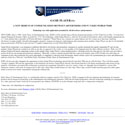 GamePlayer press release
(1088 x 1107, 0.15 MiB)
GamePlayer press release
(1088 x 1107, 0.15 MiB)
Kellysoftware.com was replaced with a placeholder sometime between December 1998 and January 1999, and then the website was parked by it's hosting provider not long afterwards. Clearly, this approach was not a market success, and it's pretty obvious why. (The present-day Kelly Software that owns this domain appears to have no relation to the Kelly Music & Entertainment Corp that made this artifact.)
The screensaver cycles through all six videos, and each one is displayed using one of five video effects. Each video can have a seperate effect selected, and can have audio toggled on/off, but the effects and videos can't be shuffled and will play in the same order every time. The effects consist of:
- Pop Shots: The video plays in the corner of the screen, and after a random amount of time a freezeframe is taken and the video moves to the next blank space on screen. As the screensaver progresses, the screen is filled with random sequential frames of video.
- Screen Shots: The video is tiled over the entire screen, and every copy of the video plays at once.
- Trail Gazer: The video bounces around the screen, leaving a trail in it's wake, similar to the effect that plays when you win a game of Solitaire.
- Drop Shot: A tetris-like effect where sections of the video fall from the top of the screen and assemble themselves at the bottom. The video loops until the entire video is assembled.
- Quick Cuts: The audio plays as normal, but instead of playing video, the screen is divided into four quadrants that show random frames of the video.
 The back of the jewel case lists these modes.
(3585 x 2780, 16.49 MiB)
The back of the jewel case lists these modes.
(3585 x 2780, 16.49 MiB)
Here's a few minutes of the screensaver playing, cycling through each of the five effects and six videos at least once:
 Screensaver example
Screensaver example
None of these effects are particularly impressive, and the audio quickly becomes annoying since all six videos use nearly identical audio with rare sound effects mixed in.
The software also includes two games: Jumblinos and Clickerinos. Jumblinos is the same tetris-like effect as Drop Shot, except the challenge is to arrange the video correctly as the pieces fall. Pieces that land in the wrong place simply disappear. Clickerinos is another simple game where the video is broken into sections, and the player matches the jumbled video sections with their corresponding pieces on the intact video. Both games are incredibly basic, and both games suffer from stretches of unplayability during sections where most of the video is black as the Myst book is falling.
Overall, this artifact suffers from similar quality problems that plagued the Riven Calendar CD, where a low-quality piece of generic software was paired with low-quality Myst assets in order to cheaply produce a Myst-branded product.
A copy of the files from this disk can be found here:
 All files on the CD
All files on the CD
 All files on the CD (Disk image)
All files on the CD (Disk image)
More pictures of the artifact are included here. Note that the jewel case uses the same texture as the blue book in-game, and the disk/booklet both use the same map as the Prima strategy guide with redrawn labels.
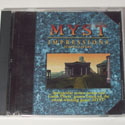 (1989 x 1731, 2.06 MiB)
(1989 x 1731, 2.06 MiB)
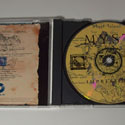 (2554 x 1339, 1.92 MiB)
(2554 x 1339, 1.92 MiB)
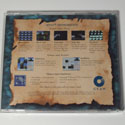 (2235 x 1848, 2.21 MiB)
(2235 x 1848, 2.21 MiB)
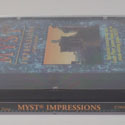 (2523 x 1269, 1.68 MiB)
(2523 x 1269, 1.68 MiB)
 (2648 x 2134, 2.64 MiB)
(2648 x 2134, 2.64 MiB)
 (2898 x 2898, 8.7 MiB)
(2898 x 2898, 8.7 MiB)
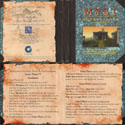 (5724 x 5702, 42.19 MiB)
(5724 x 5702, 42.19 MiB)
